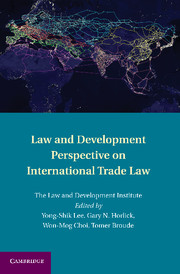Book contents
- Frontmatter
- Contents
- About the Editors and Authors
- Acknowledgments
- Law and development perspective on international trade law
- Introduction
- Part I Developing Countries and International Trade
- Part II Law and Development in the World Trade Organization
- Part III Law and Development in Free Trade Agreements
- 9 North–South Regional Trade Agreements
- 10 Free Trade Agreements
- 11 Developing Countries, Trade, and Human Rights
- 12 Free Trade Agreements and Foreign Direct Investment
- Part IV Law and Development in Regional Initiatives
- Epilogue
- Index
- References
10 - Free Trade Agreements
WTO Disciplines and Development Perspectives
from Part III - Law and Development in Free Trade Agreements
Published online by Cambridge University Press: 05 August 2011
- Frontmatter
- Contents
- About the Editors and Authors
- Acknowledgments
- Law and development perspective on international trade law
- Introduction
- Part I Developing Countries and International Trade
- Part II Law and Development in the World Trade Organization
- Part III Law and Development in Free Trade Agreements
- 9 North–South Regional Trade Agreements
- 10 Free Trade Agreements
- 11 Developing Countries, Trade, and Human Rights
- 12 Free Trade Agreements and Foreign Direct Investment
- Part IV Law and Development in Regional Initiatives
- Epilogue
- Index
- References
Summary
Proliferation of free trade agreements
Free trade agreements (FTAs) are undoubtedly becoming a prominent feature in the world trading system: in 1990, 27 FTAs had been reported to the General Agreement on Tariffs and Trade (GATT), and this number increased to 421 as of December 2008. More than 90% of the members of the World Trade Organization (WTO) are participants in FTAs. Many reasons are attributed to this increase in FTAs. Undoubtedly, this proliferation of FTAs was prompted by the failure of international trade negotiations at the WTO. WTO Ministerial Conferences failed in Seattle (1999) and Cancun (2003). Although the Hong Kong Ministerial (2005) was not a total failure, many have criticized as only half-success. The previously launched Doha Round is still stalemated. In parallel to the unsuccessful events at the WTO, trading nations negotiated FTAs with each other and came up with bilateral and regional agreements. In response to the failure of the WTO to agree on direct investment issues, trading nations also entered into many bilateral investment agreements (BITs). In 2008, the number of BITs was 2,608, and this number is still increasing.
- Type
- Chapter
- Information
- Law and Development Perspective on International Trade Law , pp. 246 - 276Publisher: Cambridge University PressPrint publication year: 2011
References
- 1
- Cited by

